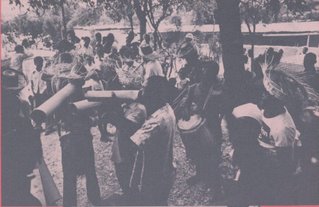
In Haiti, as many Catholics exchange the exuberant song and dance of Carnival for the somber silence of the Lentil season, a new sound of handmade bamboo or metal trumpets, called vaccine, and lively percussion emits from the streets: Rara. The festival, dance, music and ritual practice, all of the same name, provide the opportunity for practitioners of Vodou to celebrate and praise Afro-Haitian deities, or lwa. Some songs may feature sexually-provocative lyrics, while others metaphorically mock government officials. Nevertheless, the percussive rhythms are undoubtedly infectious. Rara processions can be seen and heard for miles as they chant, sing and dance. They are accompanied by instruments such as two-head and single-head drums fashioned from animal skins, trumpets, whistles, metal scrappers, shakers, percussive sticks and various others. The sound characteristic to rara is a layered-drone heard from the vaccine players created by a hocketing pattern, where one player plays one note in sequence with other players playing different notes. The combination sounds like one multi-pitched, blown instrument but is in fact created by the whole group. In Haitian Creole, gaga is the “word applied to someone not considered to be in his ‘normal’ mind.” Often seen as the Spanish rendition of the term rara, gaga is the name given to the festival and music performed by Haitian immigrants (and their Dominican-born descendants) to sugar cane plantations, ingenios, in the Dominican Republic. While rara is popular in Haiti, because of the two countries tumultuous history the celebration is outlawed in most parts of the Dominican Republic. For that reason, most gaga celebrations take place solely on bateys, or communal grounds close to the sugar cane fields where most of the migrant workers live. These bateys are under strict supervision from the Dominican government yet their inhabitants are not considered citizens and receive no assistance.
As a result of my personal experience in bateyes in the Dominican Republic, I plan to ask and hopefully answer some pertinent questions about gagá as a tool for spiritual transcendence versus/and/or as a piece of debated culture capital that can and has been commodified. By juxtaposing audio and images from early research on gagá (circa 1970s) to those of my experience in a batey, I intend to ask how could the same sounds and images be effective for an outsider and why? Batey Cero is a popular rock fusion band in the Dominican Republic that utilizes traditional Dominican rhythms and instruments (namely gagá) and incorporates them into their new sound. According to their website, "their songs reflect the magical and religious beliefs [as well as] street culture and the social problems of [the Dominican Republic]." By comparing audio and lyrics from Batey Cero to recordings of traditional gagá bands, I'll ask what purpose does Batey Cero serve within gagá and how is this new sound managed within the tradition? The purpose of this project is to give examples and samples of the magnitude of variance within gagá, and with respect to rará as an antecedent, hopefully explain gagá as an unique cultural phenomenon. The following is not meant to be a "picture-book" of gagá, but rather a collection of images, audio and video that serve to elucidate the connections between the concepts and provoke thought.


1 comment:
Justin will like to contact you urgently. Can I get your contact info?
Post a Comment